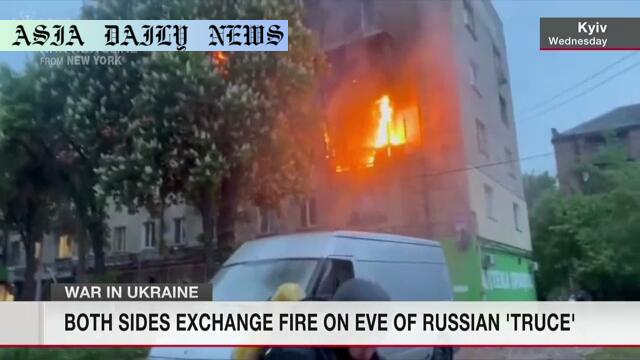Ceasefire: A three-day truce declared by Putin starts, but the fire exchange and doubt persist as Kyiv seeks lasting peace.
- A three-day ceasefire declared by Putin began Thursday yet marked by fire exchange.
- Ukraine demands a 30-day truce while missiles and drones ravage the nation.
- Foreign leaders, including China’s Xi Jinping, attend Moscow’s Victory Day parade.
- Distrust reigns as Kyiv citizens denounce the Russian government.

The State of the Ceasefire Effort
Despite a three-day ceasefire initiative declared by Russian President Vladimir Putin on Thursday, the violence endured between Russian and Ukrainian forces. The truce, coinciding with the 80th anniversary of the European armistice in World War II, aims to showcase a diplomatic gesture of goodwill. However, this intention seems to have faltered as both nations reported exchanges of fire leading up to and during the supposed ceasefire, undermining the likelihood of a temporary lull in hostilities. The targeted exchange of ballistic missiles and drone strikes across Ukraine left devastating results, while accusations of aggression are volleyed from both sides. Ukrainian Air Force authorities revealed the extent of the devastation, highlighting over 180 drones attacking the nation and the tragic loss of lives, including four children.
Kyiv’s Call for Lasting Peace
Ukrainian President Volodymyr Zelenskyy has expressed outright skepticism and dissatisfaction with the ceasefire terms, calling for a more impactful 30-day truce to promote long-term peace. Zelenskyy took to social media, advocating for effective measures that limit resources fueling the war. This rhetoric reflects Kyiv’s belief that the short-term cessation will not amend the larger issue while distrust in the opposing side’s intentions runs high. The collective sentiment from Kyiv’s residents echoes a similar mistrust towards Russian actions, with many anticipating the truce to be more of a symbolic gesture than a commitment to peace. Labeling Russian forces as ‘non-human,’ locals shared their fears, outrage, and their doubts toward Putin’s promises.
The Global Perspective and Strategic Stakes
The ceasefire coincides with Victory Day festivities in Moscow, intending to underscore Russia’s historical triumphs. The attendance of world leaders such as Chinese President Xi Jinping brings added significance to the occasion. Analysts posit that Putin’s efforts to showcase Russian strength and diplomacy seek to overshadow the ongoing turmoil surrounding the Ukrainian conflict. Putin and Xi are expected to engage in strategic dialogues addressing both the war in Ukraine and bilateral cooperation. Meanwhile, accusations from the Russian defense ministry about Ukrainian provocations demonstrate a desire to frame the narrative in favor of Kremlin actions, signaling the broader tug-of-war over public perspectives internationally.
Humanitarian and Ethical Implications
The human cost of this ongoing conflict cannot be overemphasized. As missile attacks surged ahead of the ceasefire deadline, innocent lives were lost, and several others injured. Kyiv remains a hotspot of devastation, driving further societal unrest and a growing refugee crisis. Distrust towards imposed ceasefires not only exacerbates public skepticism but undermines the progress of peacemaking initiatives. As Zelenskyy persists in rallying the global community to implement measures constraining Russian aggression, the pressing need for international engagement and humanitarian commitment emerges paramount.
The Role of Allied Nations
Foreign leaders attending Moscow’s Victory Day parades, including Xi Jinping, are perceived to play a critical role in shaping the future path of this conflict. While the United States previously disrupted international alignments through Trump-era unpredictability, a recalibration of global alliances is underway. Russia’s effort to leverage diplomatic appearances during the Victory Day celebrations signifies a push for legitimizing its stance amidst the Ukrainian conflict. As allied countries deliberate their next move, the international community’s focus lies on achieving long-lasting peace, restorative justice, and navigating the diplomatic intricacies of the war-torn landscape.



Commentary
The Illusion of Ceasefires During Conflict
The concept of a ceasefire has always been a politically charged measure, often wrapped in good intentions but stripped of genuine action. The current situation in Ukraine exemplifies this phenomenon. A three-day truce declared by Russia under Putin’s governance might appear to offer relief and hope on the surface, but reports of escalated violence preceding and during this period reduce it to a strategic maneuver rather than a humanitarian effort. The skepticism from Kyiv officials and residents is not unfounded, reflecting a pattern of distrust built over months of unresolved aggression.
Global Consequences of Local Conflicts
The Russian-Ukraine war has transcended regional borders, with its repercussions being felt globally across different spectrums – economy, politics, and societal structures. The ceasefire coinciding with the commemorations of World War II’s end adds a layer of symbolism to the situation, clouding the factual realities on the ground. Engaging global leaders from influential nations such as China shifts attention to the power dynamics involved in this geopolitical crisis. However, while headlines focus on diplomatic appearances, the individuals affected by airstrikes and drone attacks in Kyiv endure the brunt of the conflict.
Building Towards Authentic Peace
If there is to be any hope of liberating Ukraine from its current state of conflict, ceasefires must become more than temporary measures aiding selective strategic interests. Zelenskyy’s call for a more enduring resolution emphasizes the importance of critically analyzing ceasefires and holding all parties accountable for genuine adherence to their terms. Until then, international mediators and peace-seeking alliances must rally behind measures that address the root causes of such disputes. This also means working towards bridging trust gaps between conflicting parties and empowering local communities to engage in the dialogue actively.